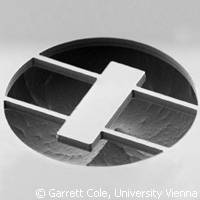Putting the 'Q' in quantum mechanics
Everything moves! But in a world dominated by electronic devices it is easy to forget that all measurements involve motion, whether it is motion of electrons through a transistor, or the simple displacement of a mechanical element. New EU-funded research suggests that quantum mechanics may hold the answer to when motion will die out. Researchers at the University of Vienna in Austria and the Technische Universität München in Germany have reported their findings, which will solve a long-standing problem in the design of micro- and nanoelectromechanical resonators, in the journal Nature Communications. Today, micro- and nanoelectromechanical resonators are used in ways similar to early force detectors, but with much greater force - now pushing to the realm of zeptonewtons (10-21 N). Among the breadth of applications that have become possible are measurements of forces between molecules and forces arising from magnetic resonance of electrons. The future for extremely small mechanical devices seems bright, yet some of their most intriguing applications remain squarely within the realm of fundamental research. Although such sensors are governed by classical physics, the imprint of quantum phenomena upon them is clearly seen in the laboratory. But it is now possible, and perhaps more intriguing, to consider intrinsic quantum fluctuations - those that belong to the mechanical device itself. What conditions are required to observe them, and what can we learn when we encounter them? Enter this latest study that investigated minimisation of energy dissipation. Specifically, when the strings of a musical instrument like a guitar are plucked, the vibrations create acoustic waves that we hear as sound. The purity of the emitted tone is intimately related to the decay of the vibration amplitude; i.e. the mechanical energy loss ('Q') of the system. The larger the quality factor 'Q', the purer the tone and the longer the system will vibrate before the sound damps out. Until now, however, it remained a challenge to make accurate numerical predictions of the attainable 'Q' for even relatively straightforward geometries. The research team developed a finite-element-based numerical solver capable of predicting the design-limited damping of almost arbitrary mechanical resonators to resolve this problem. 'We calculate how elementary mechanical excitations, or phonons, radiate from the mechanical resonator into the supports of the device', says Garrett Cole, senior researcher in the Aspelmeyer group at the University of Vienna. The idea goes back to previous work by Ignacio Wilson-Rae, a physicist at the Technische Universität München. In collaboration with the Vienna group, the team came up with a numerical solution to compute this radiation in a simple manner that works on any standard PC (personal computer). The predictive power of the numerical Q-solver removes any guesswork currently involved (namely the fabrication of trial and error prototype) in the design of resonant mechanical structures. The researchers point out that it is scale independent and can be applied to nanoscale devices - all the way up to macroscopic systems. This study was funded in part by the following EU projects: MINOS ('Micro- and nano-optomechanical systems for ICT and QPIC'); QESSENCE ('Quantum interfaces, sensors and communication based on Entanglement'); IQOS ('Integrated quantum optomechanical systems'); and QOM ('Quantum optomechanics: quantum foundations and quantum information on the micro- and nanoscale') Both MINOS and QESSENCE are backed under the 'Information and communication technologies' Theme of the Seventh Framework Programme (FP7) to the tune of EUR 2.27 million and EUR 4.7 million respectively. IQOS has received a Marie Curie Action 'International Incoming Fellowships' grant worth EUR 171,412 under FP7, and QOM has clinched a European Research Council Starting Grant valued at EUR 1.67 millionFor more information, please visit: University of Viennahttp://www.univie.ac.at/?L=2Technische Universität Münchenhttp://portal.mytum.de/welcome/Nature Communicationshttp://www.nature.com/ncomms/index.html
Countries
Austria, Germany



